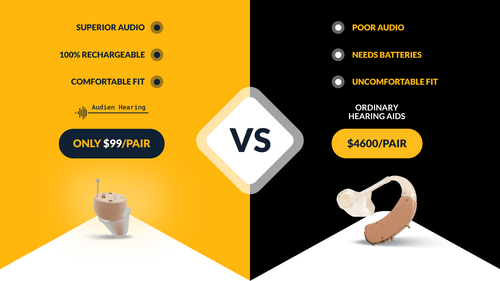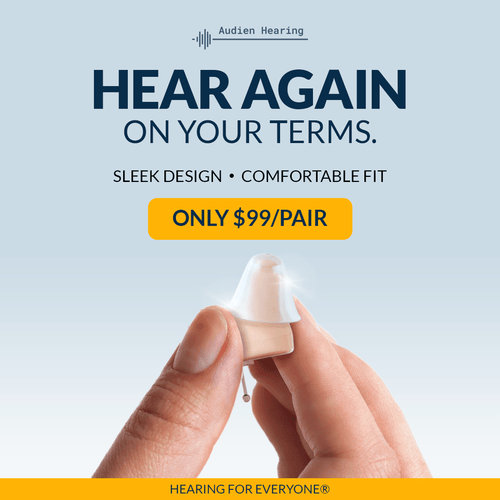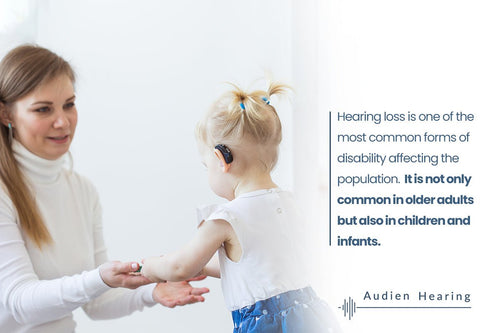
Hearing loss can be mild, moderate, severe, or profound. In most cases, hearing can be enhanced with the help of hearing aids, and this is one of the major needs of people with hearing loss.
Hearing aids are devices that have been specially designed to help people with hearing loss hear and communicate effectively. In recent times more people have begun to turn hearing aids alternatives. One of such alternatives is personal sound amplifying products.
In this article, we will be individually examining the hearing aid and PSAPs; then, we will tell you the difference between them and which of them is suitable for people with hearing loss.
Hearing Aids

Hearing aids are digital devices that are designed to improve the hearing of people with hearing loss by amplifying or making sounds audible. Hearing aids have been around since the 17th century. Ear trumpet or ear horns are one of the earliest forms of hearing aids. They were designed to gather sound energy and channel it directly into the ear canal.
However, in recent times, hearing aids are computerized electroacoustic devices that make environmental noise audible according to audio metrical and cognitive rules.
Modern hearing aids are configured or personalized to suit the degree of hearing loss, lifestyle, and physical features of the wearers. The hearing aid also needs to pass through a process called fitting. This is the programming of the hearing aid to the most recent audiogram by frequency. The efficiency of a hearing aid is dependent on the quality of its fitting.
Hearing aids make use of sophisticated digital signal processing to improve speech intelligibility for the user. These signal processing include frequency lowering, feedback management, noise reduction, and wide dynamic range compression directionality.
Hearing aids are classified as medical devices and in countries like the United States of America, and the FDA regulates them. Before a type of hearing aid is made available to the public, it undergoes extensive testing to ensure appropriate use. The good thing about hearing aids is that there are hearing aids available for every degree of hearing loss.
There are various types of hearing aid models in the market. This classification is done based on the location or positioning of the hearing aid in the ear. The sizes of each type of hearing aid vary this is due to the demand for less visible hearing aids. The downside of this is that the smaller the hearing aid, the lesser its efficiency.
Below are some major types of hearing aid models.
1.Behind-the-ear (BTE)
These hearing aids are custom-molded so that they can perfectly hook over the top of the ear and rest behind the ear. The positioning of it behind the ear doesn't make it less effective because it has specially engineered tubes known as directional microphones through which sound is directed into the ear canal.
Behind-the-ear hearing aids are the largest types of hearing aids. Some new mini designs are barely visible, but they are not yet widely used.
BTE hearing aids are suitable for people of any age and any degree of hearing loss.
The directional microphones that BTE hearing aids have, gives them more sound amplification than other types of hearing aids. they can pick more wind noise than other styles.
2. In-the-ear (ITE)
ITE hearing aids have two directional microphones, and they are suitable for people with mild to severe hearing loss, especially low-dexterity ones. In-the-ear hearing aids are custom-made in two styles. The first style fills the majority of the bowl-shaped area of the outer ear, while the second type fills only the lower part of the outer ear.
Even though In-the-ear hearing aids are not as big as behind-the-ear hearing aids, they still have certain features such as volume control which are not available on smaller types of hearing aids. They are also easier to handle, and the batteries are larger, with longer battery life.
In-the-ear hearing aids are susceptible to being clogged by earwax. Due to its location in the outer ear, earwax in the ear can get into the hearing aid and clog the speaker.
3. In-the-canal (ITC)
In-the-canal hearing aids are designed to fit partly in the ear canal. They are smaller in size and less visible in the ear than larger styles. They are suitable for adults with mild to moderate hearing loss.
Like In-the-ear hearing aids, the speakers of these hearing aids can easily be clogged with earwax.
4. Receiver-in-canal (RIC)
This type of hearing aid is also known as a receiver-in-the-ear (RITE) hearing aid. Like the behind-the-ear hearing aid, this type of hearing aid has a speaker or receiver sitting in the ear canal. But instead of a tube, a tiny wire connects the piece behind the ear to the speaker in the ear canal.
This type of hearing aid is less visible behind the ear portion; it also has directional microphones and can be controlled manually. However, the section of the hearing aid in the ear canal is susceptible to ear wax clogging.
5. Completely-in-the-canal (CIC)
Just as the name implies, this hearing aid is designed to seat completely inside the ear canal. It is suitable for people with mild-to-moderate hearing loss. It is the smallest and least visible type of hearing aid.
Due to its small nature, it is less likely to pick up when noise. It is difficult to handle and has small batteries with a short lifespan. It also doesn't have extra features like directional microphones or volume control. The Speaker of this type of hearing aid can easily be closed by earwax due to its position in the ear canal.
6. Open Fit
An open-fit hearing aid is like a behind-the-ear hearing aid with a thin tube or a receiver-in-the-ear hearing aid with an open dome in the ear. Low-frequency sounds can enter the ear naturally because the open-fit hearing aid keeps the ear canal very open. The hearing aid amplifies high-frequency sounds.
The dome is not customized, so it is often difficult to fit into the ear, and it doesn't plug the ear like the other types of aids. It is, however, suitable for people with mild to moderate high-frequency hearing loss.
Personal Sound Amplification Products (PSAPs)
PSAPs, also known as Personal Sound Amplification Devices, are wearable electronic devices or products that help to amplify sounds for people that are deaf or suffer hearing loss.
The FDA does not classify PSAPs as hearing aids because they do not meet the manufacturing and safety standards for hearing aids.
Despite the FDA's stance on PSAPs, most people consider PSAPs to be an affordable alternative to hearing aids. Because they are not classified as medical devices, PSAPs can be bought over the counter or online for as cheap as fifty dollars.
While PSAPs may not have the features and fittings to help people with hearing loss, the FDA considers them to be good alternative options for hearing soft sounds during lectures, presentations, or recreational activities such as hunting or bird watching.
Unlike hearing aids, they do not need to be fitted by an audiologist, PSAPs can be self-fitted or self-programmed using smartphones or computers. PSAPs are not just restricted to volume amplification; there are improved PSAPs that perform the basic functions of hearing aids.
However, this does not mean that they can substitute hearing aids. PSAPs just fill the need for people with mild hearing loss who need sound amplification in certain situations. Using PSAPs as a substitute for hearing aids can do more harm than good to your hearing in the long run.
PSAPs Versus Hearing Aids
As stated earlier, PSAPs and hearing aids are not the same; neither can they substitute each other. In this section, we will be looking at the differences between each of these devices and giving you our verdict on which one you should use.
Below are the differences between PSAPs and hearing aids.
1.Class of Product
Hearing aids are classified by the FDA as medical devices and are suitable for compensating for hearing loss. Hearing aids can only be gotten from hearing healthcare professionals.
PSAPs, on the other hand, are just sound amplifiers and the FDA only approves the use of PSAPs for people without hearing impairment. Unlike hearing aids, PSAPs can be gotten over the counter without any prescription. They can also be purchased online.
2. Cost
Hearing aids are relatively expensive. The average cost of a hearing aid is between 1000 to 3000 dollars. The high cost of hearing aids makes them inaccessible to the majority of people with hearing loss. Only about ten to twenty percent of people with hearing loss can afford a hearing aid.
PSAPs are cheaper, even though they are not designed to aid or improve people’s hearing with hearing loss. They are often considered a cheaper alternative to hearing aids, especially for people who need sound amplification. The average cost of PSAPs is between $50 to $500.
3. Features and Fitting

Hearing aids are specifically made for people with varying degrees of hearing loss and can only be fitted and programmed by an audiologist. Each hearing aid is designed to fit the user’s specific hearing needs, and they are custom programmed by audiologists. Hearing aids also have features like tinnitus control, streaming capabilities, and directional microphones.
Unlike hearing aids, PSAPs are only available in standard settings. PSAPs are one size fits all; they can't be custom-programmed.
PSAPs also do not have any additional features; they consist of a microphone, an amplifier, and a receiver.
4. Amplification Style
Hearing aids are designed to selectively amplify only the necessary sounds while reducing background noise and feedback. This enables people with hearing loss to communicate effectively, especially in crowded places.
PSAPs, on the other hand, are designed to amplify all sounds within a radius, including the unnecessary ones. The amplification of every sound around can damage your ears if the sound level exceeds the ears’ appropriate decibels.
PSAPs may be great for amplifying sounds, but that's how much they do. They can't enhance hearing, but they can damage your ears. The fact that they cannot be custom-programmed makes it a horrible choice for anyone with hearing loss. Because no two hearing loss cases are identical, a one size fits all device will not improve your hearing.
In addition to not being medically recommended for hearing loss, PSAPs can also increase the risks of having impacted earwax. The inserts on PSAPs can push earwax deeper into the ear.
Conclusion
If you are considering buying a PSAP for the sole purpose of amplifying sounds, then that's great. If you have a hearing loss problem, a device you get over the counter or online is not for you. You need to see a doctor. After proper examination, the right type of hearing aid will be prescribed.
Have you used either a hearing aid or a PSAP? Did it improve your hearing? Share your experience with us.













